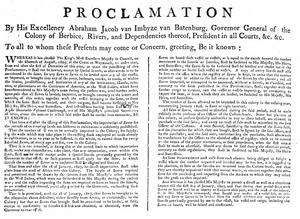
The top part of the Proclamation issued by Governor Imbyze van Batenburg of Berbice on November 30, 1805
| Related Links: | Articles on history |
| Letters Menu | Archival Menu |

Next year the UK and various of our sister Caricom states are gearing up for a series of major events commemorating the two hundredth anniversary of the abolition of the African Slave Trade throughout the British dominions. It was abolished by act of Parliament on March 25, 1807, and became effective from May 1 of that year.
No doubt Guyana too will be caught up in these activities, at least the ones relating to the various academic symposia which will presumably be held. However, it should be recognized that the African Slave Trade was not abolished here by act of Parliament, but by an Order-in-Council issued by the King in Council from the seaside town of Weymouth on August 15, 1805, although the critical portion only came into operation on January 1, 1807.
There had been attempts both in 1804 and 1805 to pilot abolition bills through the British Parliament, but these had failed. However, there were certain territories in this region which had been captured by Britain during the Napoleonic wars, including the Dutch Guiana colonies. Known as ceded territories, they came under the direct control of the Crown, and therefore were not subject to the jurisdiction of the Parliament in London.
At the time this country comprised two colonies - Essequibo & Demerara, and Berbice. The other territories with the same ceded status in the region as ourselves were Suriname (which had also been captured by Britain, but was to be returned to the Dutch at the end of the Napoleonic wars), Tobago and St Lucia.
The relevant Proclamation based on the Order-in-Council of August 15, 1805, was issued both in Berbice and Demerara on November 30 of that year, and it stated that after January 1, 1807, there should be no "direct importation‚€¦ from the coast of Africa ."
However, there were also restrictions on the number of Africans who could be imported in the meantime, and these provisions were to have immediate effect. It was prohibited, for example, to import any Africans at all for the purposes of new cultivation, while there was a ceiling on the totals which could be imported to replace losses in the existing complement for lands already under cultivation. That ceiling was fixed at three for every hundred Africans of every age and sex. The total number of Africans who could be imported for the year 1806 was set at 800 for Berbice, and 2000 for Demerara and Essequibo. After January 1, 1807, the replacements could only come from other British colonies in the West Indies. So there was not a full cessation of a Slave Trade as such.
There were, of course, qualifying clauses in the Proclamation (including with regard to numbers) as well as provisions relating to licences and censuses, etc. Suffice it to say that there were enough loopholes in the Order to allow planters the manoeuvrability to maintain their work-force possibly at the level they saw fit.
Dr Shahabuddeen in his work Constitutional Development in Guyana 1621-1978, basing himself on some earlier historians says that the older British plantocracies like Jamaica and Barbados were afraid of the Guiana colonies, because with their virgin soils they could out-produce them and would prove a threat in Britain's protected sugar market. While their planter lobbies, particularly in the House of Lords, had effectively blocked abolition moves up until that point, they were not averse to the Crown first restricting labour imports and then stopping the Slave Trade in the ceded territories specifically in order to blunt their competitive edge.